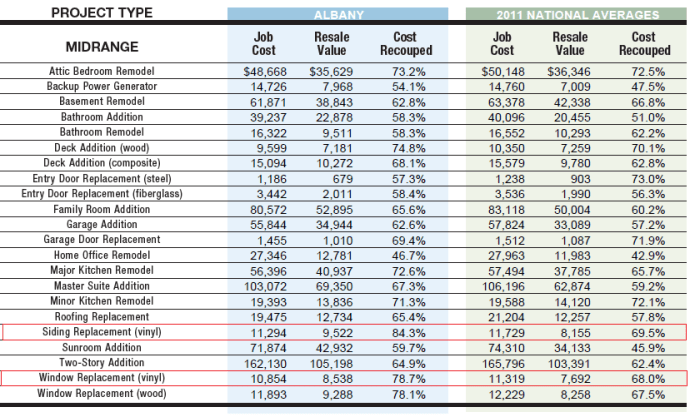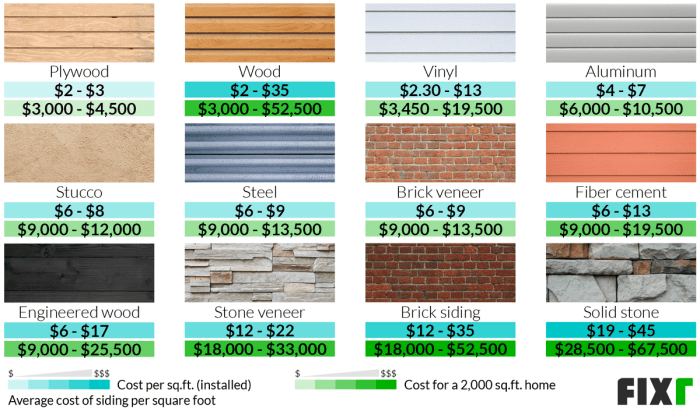Siding Replacement Cost vs. Value: A Complete ROI Breakdown.
Siding Replacement Cost vs. Value: A Complete ROI Breakdown. sets the stage for this enthralling narrative, offering readers a glimpse into a story that is rich in detail and brimming with originality from the outset.
As we delve into the intricacies of siding replacement costs and the value they bring, a comprehensive understanding of the topic unfolds before us.
Factors Impacting Siding Replacement Cost

When considering siding replacement, there are several key factors that can significantly impact the overall cost. Understanding these factors is essential for homeowners planning to invest in improving their property's exterior.
Types of Siding Materials and Costs
Different types of siding materials come with varying costs. For example, vinyl siding is often more affordable than fiber cement or wood siding. The choice of material will directly influence the total cost of the replacement project.
Size of the Home
The size of the home is a crucial factor in determining the cost of siding replacement. Larger homes will require more materials and labor, leading to higher overall costs. It's important to consider the square footage of the property when budgeting for the project.
Labor Costs
Labor costs play a significant role in the total cost of siding replacement. Hiring skilled professionals to install the siding properly is essential but can also contribute to higher expenses. The complexity of the job and the time required for installation will impact labor costs.
Additional Expenses
In addition to material and labor costs, homeowners should also budget for additional expenses such as permits, disposal fees, and unforeseen repairs. Permits may be required for the project, and disposal fees can add to the overall cost. Unforeseen repairs, such as fixing underlying structural issues, can also increase expenses unexpectedly.
Calculating ROI for Siding Replacement
When considering the return on investment (ROI) for siding replacement, it is essential to take into account various factors that can impact the value added to your home. Calculating ROI involves comparing the upfront cost of siding replacement with the potential increase in property value.
Factors Contributing to Value Added
- Quality of Materials: Investing in high-quality siding materials can significantly increase the curb appeal and durability of your home, contributing to a higher property value.
- Curb Appeal: Updated siding can enhance the overall look of your home, attracting potential buyers and increasing its market value.
- Energy Efficiency: Certain siding materials, like insulated vinyl or fiber cement, can improve energy efficiency, leading to lower utility bills and adding value to your property.
Comparing Costs and Potential Increase in Property Value
- Upfront Cost: The cost of siding replacement can vary based on the material chosen, the size of the project, and the complexity of the installation. It is essential to consider this initial investment when calculating ROI.
- Potential Property Value Increase: Research shows that siding replacement can offer a high ROI, with some studies suggesting a return of over 70% of the project cost in increased property value.
Examples of ROI Variation
- Vinyl Siding: While vinyl siding is a more budget-friendly option, it may offer a lower ROI compared to premium materials like fiber cement or natural wood due to its shorter lifespan and lower durability.
- Professional Installation: Opting for professional installation, though it may come at a higher cost initially, can result in a better ROI as it ensures proper installation and long-term performance of the siding.
Popular Siding Materials and Their Costs
When considering siding replacement, it's essential to weigh the costs and benefits of different siding materials. Here, we compare the cost per square foot of popular siding materials like vinyl, wood, fiber cement, and metal, along with their durability, maintenance requirements, and aesthetic appeal.
Comparing Popular Siding Materials
| Siding Material | Cost per Square Foot | Durability | Maintenance Requirements | Aesthetic Appeal |
|---|---|---|---|---|
| Vinyl | $3-$7 | Durable, low maintenance | Occasional cleaning | Versatile, various colors |
| Wood | $7-$12 | Natural appeal, requires maintenance | Regular painting or staining | Classic, timeless look |
| Fiber Cement | $5-$10 | Durable, low maintenance | Periodic painting, caulking | Resembles wood, modern finishes |
| Metal | $8-$15 | Highly durable | Minimal maintenance | Contemporary, industrial look |
Choosing the Best Value Siding Material
When it comes to longevity and cost-effectiveness, fiber cement and vinyl siding materials often offer the best value. They strike a balance between durability, low maintenance, and aesthetic appeal, making them popular choices for homeowners looking for a long-lasting siding solution without breaking the bank.
Real-Life Examples
Consider a home with vinyl siding that requires minimal maintenance over the years, retaining its vibrant color and appeal. In contrast, a house with wood siding may demand regular upkeep like painting or staining, adding to the overall cost of ownership.
By comparing these real-life examples, homeowners can see the tangible differences in cost versus value when selecting the right siding material for their homes.
Hiring Professionals vs. DIY for Siding Replacement
When it comes to siding replacement, homeowners often face the decision of whether to hire professionals or tackle the project themselves. Both options have their pros and cons, which should be carefully considered before making a choice.
Benefits of Hiring Professionals
- Professionals ensure quality workmanship, using their expertise to install siding correctly and minimize the risk of future issues.
- Most professional siding companies offer warranties on their work, providing homeowners with peace of mind in case any problems arise after installation.
- Professional installers are usually more time-efficient, completing the project in a shorter timeframe compared to DIY projects.
Risks and Challenges of DIY Siding Replacement
- DIY projects can lead to errors in installation, which may compromise the effectiveness and longevity of the siding.
- Lack of experience and knowledge in siding installation can result in costly mistakes that require additional repairs.
- DIY projects can be time-consuming and may take much longer to complete, especially for homeowners with limited availability.
Cost Comparison: Professional Installation vs. DIY
- While professional installation may come at a higher initial cost, it often pays off in the long run by avoiding potential issues and ensuring a high-quality finish.
- DIY projects can save money on labor costs, but homeowners should consider the value of their time, potential mistakes, and the need to invest in tools and equipment.
Tips for Decision-Making
- Assess your budget and determine if the cost of professional installation fits within your financial constraints.
- Evaluate your skill level and comfort with DIY projects to decide if you have the necessary expertise to complete the siding replacement successfully.
- If unsure, consider consulting with professional siding companies for quotes and advice to make an informed decision based on your specific needs.
Ending Remarks

In conclusion, Siding Replacement Cost vs. Value: A Complete ROI Breakdown sheds light on the critical aspects of making informed decisions about home improvement projects, leaving readers equipped with valuable insights to navigate the realm of siding replacements with confidence.
Query Resolution
What are the key factors influencing siding replacement costs?
The type of siding material, home size, labor costs, permits, disposal fees, and unforeseen repairs all play significant roles in determining the total cost.
How can homeowners calculate the ROI for siding replacement?
Homeowners can calculate ROI by comparing the upfront cost of siding replacement with the potential increase in property value after the project is completed.
What are the benefits of hiring professionals for siding replacement?
Professional installation offers quality work, warranties, and time efficiency compared to the risks and challenges associated with DIY projects.




